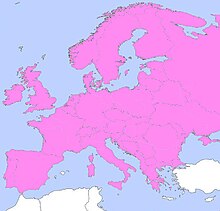歐洲山芥
| 歐洲山芥 | |
|---|---|

| |
| 歐洲山芥 | |
| 科學分類 | |
| 界: | 植物界 Plantae |
| 演化支: | 維管束植物 Tracheophyta |
| 演化支: | 被子植物 Angiosperms |
| 演化支: | 真雙子葉植物 Eudicots |
| 演化支: | 薔薇類植物 Rosids |
| 目: | 十字花目 Brassicales |
| 科: | 十字花科 Brassicaceae |
| 屬: | 山芥屬 Barbarea |
| 種: | 歐洲山芥 B. vulgaris
|
| 二名法 | |
| Barbarea vulgaris R. Br.
| |

| |
| 異名 | |
| |
歐洲山芥(學名:Barbarea vulgaris)為十字花科山芥屬下的一個種。
特徵[編輯]
歐洲山芥中包含的化學物質有皂素、類黃酮[1]和芥子油苷。[2][3]
病蟲害抵禦[編輯]
歐洲山芥可以抵抗大多數十字花科害蟲(例如小菜蛾),其抗性來源自所含的皂素。[4][5][6][7]芥子油甙則可以吸引一些昆蟲,因此會被種在農田周圍,以免這些昆蟲危害農作物。[8]
參考文獻[編輯]
- ^ Dalby-Brown, Lea; Olsen, Carl Erik; Nielsen, Jens Kvist; Agerbirk, Niels. Polymorphism for Novel Tetraglycosylated Flavonols in an Eco-model Crucifer, Barbarea vulgaris. Journal of Agricultural and Food Chemistry. 2011, 59 (13): 6947–56. PMID 21615154. doi:10.1021/jf200412c.
- ^ Agerbirk, Niels; Olsen, Carl Erik. Isoferuloyl derivatives of five seed glucosinolates in the crucifer genus Barbarea. Phytochemistry. 2011, 72 (7): 610–23. PMID 21354584. doi:10.1016/j.phytochem.2011.01.034.
- ^ Agerbirk, Niels; Ørgaard, Marian; Nielsen, Jens Kvist. Glucosinolates, flea beetle resistance, and leaf pubescence as taxonomic characters in the genus Barbarea (Brassicaceae). Phytochemistry. 2003, 63 (1): 69–80. PMID 12657300. doi:10.1016/S0031-9422(02)00750-1.
- ^ Kuzina, V.; Ekstrom, C. T.; Andersen, S. B.; Nielsen, J. K.; Olsen, C. E.; Bak, S. Identification of Defense Compounds in Barbarea vulgaris against the Herbivore Phyllotreta nemorum by an Ecometabolomic Approach. Plant Physiology. 2009, 151 (4): 1977–90. PMC 2785962
 . PMID 19819983. doi:10.1104/pp.109.136952.
. PMID 19819983. doi:10.1104/pp.109.136952.
- ^ Kuzina, Vera; Nielsen, Jens Kvist; Augustin, Jörg Manfred; Torp, Anna Maria; Bak, Søren; Andersen, Sven Bode. Barbarea vulgaris linkage map and quantitative trait loci for saponins, glucosinolates, hairiness and resistance to the herbivore Phyllotreta nemorum. Phytochemistry. 2011, 72 (2–3): 188–98. PMID 21130479. doi:10.1016/j.phytochem.2010.11.007.
- ^ Nielsen, Nikoline J.; Nielsen, John; Staerk, Dan. New Resistance-Correlated Saponins from the Insect-Resistant CruciferBarbarea vulgaris. Journal of Agricultural and Food Chemistry. 2010, 58 (9): 5509–14. PMID 20387830. doi:10.1021/jf903988f.
- ^ Shinoda, Tetsuro; Nagao, Tsuneatsu; Nakayama, Masayoshi; Serizawa, Hiroaki; Koshioka, Masaji; Okabe, Hikaru; Kawai, Akira. Identification of a triterpenoid saponin from a crucifer, Barbarea vulgaris, as a feeding deterrent to the diamondback moth, Plutella xylostella. Journal of Chemical Ecology. 2002, 28 (3): 587–99. PMID 11944835. doi:10.1023/A:1014500330510.
- ^ Shelton, A. M. and B. A. Nault (2004) "Dead-end trap cropping: a technique to improve management of the diamondback moth," Crop Protection 23: 497-503.
擴展閱讀[編輯]
| ||||||||||||
|
| 這是一篇十字花科小作品。你可以透過編輯或修訂擴充其內容。 |
